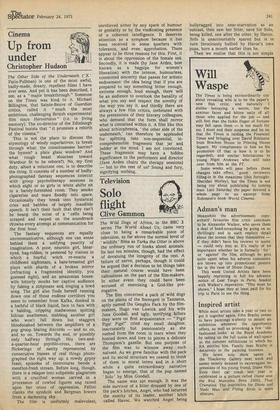Television
Solo flight
Clive Gammon
The Wild Dogs of Africa, in the BBC 2 series The Woad About Us, came very close to being a remarkable piece of television, as far above the normal level of ' wildlife ' films as Tarka the Otter is above the ordinary run of books about animals.
Its last ten minutes, though, had the effect of devaluing the integrity of the rest. A failure of nerve, perhaps, though it could be argued that a decision to let things take their natural course would have been callousness on the part of the film-makers.
In either event they could have been accused of exercising a God-like prerogative.
The film concerned a pack of wild dogs on the plains of the Serengeti in Tanzania, aptly named the Genghis Pack by the film makers, Hugo van Lawick and his wife Jane Goodall, and ugly, terrifying killers they were on first acquaintance — " Pigs!
Pigs! Pigs!" cried my small daughter, inaccurately but passionately as she rushed from the room in tears when they hunted down and tore to pieces a delicate Thompson's gazelle. But one purpose of the film was to winnow away such naivete. As we grew familiar with the pack and its social structure we ceased to think of them in moral terms and in a short while a quite extraordinary narrative began to emerge, that of the pup named ' Solo ' by Miss Goodall.
The name was apt enough. It was the sole survivor of a litter dropped by one of the pack's bitches, Angel, who had incurred the enmity of its leader, another bitch called Havoc. We watched Angel being bullyragged into near-starvation as an outcast, then saw her litter, save for Solo, being killed, one after the other, by Havoc. Solo is unaccountably spared but is in turn ferociously bullied by Havoc's own pups, born a month earlier than he.
Then we realise that this is not simple
bullying. Havoc's litter is practising on Solo, dragging at its tail and muzzle in just the same way that the mature dogs of the pack used to pull down a zebra. It seems unlikely that Solo can survive, especially as it is denied milk by its terrified, skulking mother, herself now abused by Havoc's growing pups.
By this stage of the film, in spite of the best intentions to remain detached, I found it impossible not to identify with Solo, so patently a small, indomitable creature hanging with all its power to life.
Inevitably the film had changed from a brilliantly-observed account of some interesting animals to a compelling drama.
This reached its height when the pack had to migrate in search of food and Solo, a month too young for such a journey, had to follow it •to survive. For six days and forty miles the pup followed, lagging further and further behind until he finally lost sight of the pack • which earlier had shown signs of accepting him, driving off first a leopard then a hyena.
This, in nature, would have been the end. But the gods leapt from their machine, the tracking Landrover, and rescued him, bearing him back to camp to be fed meat and to be fussed over by their small boy until eventually they released him in the wild again, to be accepted this time by another bitch and her litter.
You can understand their predicament. For the sake of an honest film, should they have filmed the death of Solo in the harsh yellow grass of the Serengeti? Or provided the happy ending, as they did? The harsher alternative would have been infinitely more memorable.



































 Previous page
Previous page